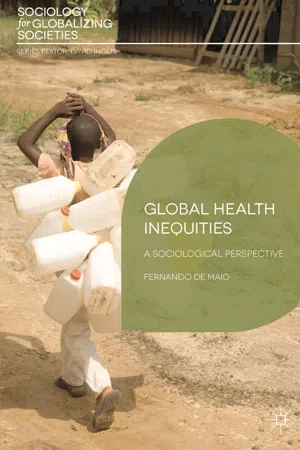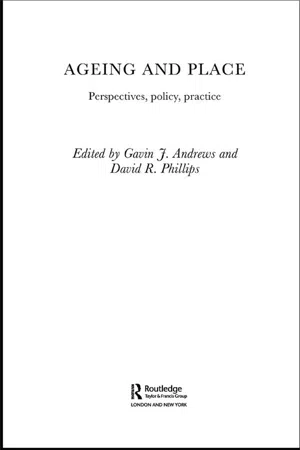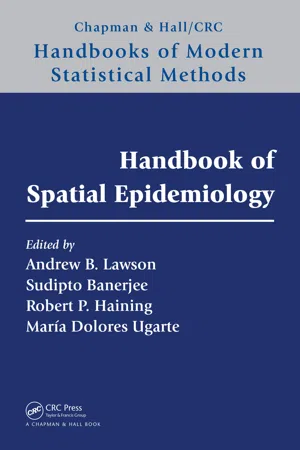Geography
Epidemiological Transition
Epidemiological transition refers to the shift in the patterns of health and disease within a population. It involves a transition from high mortality and infectious diseases to lower mortality and an increased prevalence of chronic diseases. This transition is often associated with changes in lifestyle, healthcare, and socioeconomic development within a society.
Written by Perlego with AI-assistance
Related key terms
1 of 5
10 Key excerpts on "Epidemiological Transition"
- eBook - PDF
Global Health Inequities
A Sociological Perspective
- Fernando De Maio(Author)
- 2014(Publication Date)
- Bloomsbury Academic(Publisher)
The Epidemiological Transition The Epidemiological Transition is one of the core tenets of the global health research literature. It is a theory that seeks to explain a society’s population health profile, and how it changes over time. First developed by the Egyptian-born demographer Abdel Omran, Epidemiological Transition theory describes a change in a country’s leading causes of death from infectious (or communi-cable) to chronic (or non-communicable) diseases (see Omran, 1971, 1983). The classic formulation of this model posits that the transition is primarily associated with a country’s economic development. It describes how countries transition over time from an ‘era of pestilence and famine’, characterized by brutally low life expectancies and outbreaks of infectious pathogens, to an era of ‘man-made and degenerative’ diseases, where life expectancy is high and mortality relatively predictable from one year to the next. As a theoretical framework, the Epidemiological Transition is often implicit in global health thinking. It is often taken for granted that the model works, and that it describes with some degree of precision the development of global health over time. Yet, researchers have also paused to ‘unpack’ the model, sometimes developing ways of extending the theory to better fit contemporary epidemiolog-ical profiles in specific countries and regions (Cook and Dummer, 2004; Gaylin and Kates, 1997; Heuveline et al. , 2002; Waters, 2006). Other researchers, as I show in this chapter, have been critical of the theory’s underlying assumptions, critiquing it as part of a larger ideology of oppression and structural violence (Avilés, 2001). - eBook - ePub
- Gavin J. Andrews, David R. Phillips(Authors)
- 2004(Publication Date)
- Routledge(Publisher)
Omran’s descriptive model of Epidemiological Transition has certainly been very useful and has stimulated debate and research. One aspect that has attracted attention is the reasons for improving or changing health. Some researchers suggest placing emphasis on scientific advances as driving many social and other developments, as well as being intricately bound up with modernisation itself. Caldwell argues that ‘expressing the change as being essentially socioeconomic subtly downgrades the specific contributions made by public health interventions and especially by breakthroughs in medical science’ (2001: 160). Others note that the bulk of early mortality decline from infectious diseases in the West in particular had actually started before the infectious disease immunisation discoveries (McKeown, 1976; McCracken and Curson, 2000). By contrast, it could be said that public health campaigns and in particular the availability of immunisations for childhood killers like measles and others such as tuberculosis have had a greater impact in today’s Third World countries although, again, it is difficult to disentangle their impacts from those of general improvements in living standards. Thus Epidemiological Transition is very varied and, indeed, there may be as many models of ET as there are societies. As well, the transition varies socially and spatially within countries (Caldwell, 2001; Phillips, 1993). Any idea of a single, pre-determined epidemiological pathway as a natural destiny of societies is thus naive and mis-informative (Carolina and Gustavo, 2003).Figure 4.6 Leading causes of the burden of disease by age, both sexes, 1998, low and middle income countries. Source: WHO (2002) p. 15, Fig. 6.Some researchers outline a broader health transition rather than an epidemiological (mortality) transition, comprising a set of interlinked changes involving the demographic movement from high to low fertility, steady expansion of life expectancy at birth and also at older ages, and shifting causes of ill health (morbidity) as well as mortality. The health transition has undoubtedly occurred, albeit in a spatially varied form, and has been fostered by many changes related to modernisation and urbanisation over the past decades, importantly, but not solely, by improvements in health care as well as standards of living and education. However, it is important to remember that health transition improvements can also be lost due to socio-political, economic and other upheavals. The declining health status and reductions in life expectancy in Russia during and after the breakup of the Soviet Union around the late 1980s and into the 1990s and the reversals in the African AIDS-belt nations discussed earlier are telling examples.Healthy life expectancy: a major question in ageing populations
Whatever the specific mix of underlying reasons, Epidemiological Transition and a broader health transition have certainly occurred almost everywhere. As well as the radical changes in fertility discussed above, all countries have witnessed a greater or lesser change in the balance of causes of deaths (mortality) and ill health (morbidity) in their populations over the course of the twentieth century and especially in its closing few decades. While mortality has traditionally been used as an indicator of population health status and the need for health and welfare services, it is increasingly recognised that a people’s lifetime health status (how healthy or ill they have been) is the major influence on well-being and the need for health and other support services. In low-mortality countries in particular, counting most countries of the West and many in Asia and Latin America, death often follows only as one event after a life which has had a greater or lesser amount of chronic and acute illness (Ratzan et al. - eBook - ePub
- Peter N. Hess(Author)
- 2016(Publication Date)
- Routledge(Publisher)
In this chapter we will discuss both population transitions, not only explaining the trends in mortality and fertility, but addressing future concerns with the aging of populations. Fertility transitions in the United States, Europe, and China will be highlighted.THE Epidemiological Transition
Epidemiologyis the study of health in populations, including illness, disease, and epidemics (outbreaks of rapidly spreading, contagious diseases). The Epidemiological Transition explains how with improved standards of living, education, and health care, the major causes of mortality change from famine and contagious or communicable diseases—whether spread by germs (e.g., diarrhea, measles, tuberculosis) or pests (e.g., bubonic plague, malaria), reflecting environmental conditions—to noncommuni cable diseases (e.g., cardiovascular diseases, cancers, diabetes, and chronic lung illnesses), some reflecting poor choices (e.g., unhealthy diets, smoking), but also biological factors (genes and aging). In essence, with economic development, people live longer to be susceptible to noncommunicable diseases. Four major stages have been identified.1The first stage of the Epidemiological Transition, theage of epidemics and famine, corresponds to the traditional stage of the demographic transition, which has defined most of human existence. Death rates are high and volatile due to epidemics, famine, and violence.2With advances in agriculture, however, famines diminish in importance as a major cause of mortality, while diseases become more consequential.3 As populations cluster in cities with unsanitary conditions, contagious diseases spread more easily. The life expectancy at birth during this stage might rise to as high as 35 to 40 years.The second stage is theage of receding epidemics, which corresponds to the first part of the transition stage where death rates are significantly declining while fertility rates remain high. Here humans begin to gain some control over their environment. Average levels of nutrition improve with more reliable food supplies. Populations become more resistant to disease and better able to withstand illness. Later advances in medicine (e.g., a small pox vaccine at end of the nineteenth century) and improvements in public health and sanitation further reduce mortality. Life expectancies might rise to 50 years as infectious and parasitic diseases gradually come under control.4 - eBook - ePub
Ecological Public Health
Reshaping the Conditions for Good Health
- Geof Rayner, Tim Lang(Authors)
- 2013(Publication Date)
- Routledge(Publisher)
What is the value of the notion of the Demographic Transition for a twenty-first-century conception of public health? Firstly, it focuses on a key element of humanity’s ecological and material challenge: how to juggle the enormous tasks of feeding people, making the economy work to enable decent quality of lives, and managing planetary conditions. Secondly, it suggests that it is inevitable that theories are needed to interpret evidence and reality if one takes a population rather than an individual perspective on health. Thirdly, it reveals variations in the conditions facing humanity in different parts of the world, and also reveals how people’s intimate choices – how and when to have children – are shaped by forces beyond individual volition. Over the twentieth century the question of finite limits to population growth sporadically disappeared only to return again and again. Larger populations use more resources; ageing populations unbalance patterns of economic dependency between generations. Reviled and rejected, the figure of Malthus still casts a shadow over humankind’s growth and level of population.Passage contains an image
5 Epidemiological and Health Transition
DOI: 10.4324/9780203134801-7The term ‘Epidemiological Transition’ is attributed to the American-domiciled but Egyptian-born Abdel Omran (1925–99). In seminal papers from the late 1960s, Omran argued that there was an observable sequence of disease patterns linked to economic and societal development. This notion captures how patterns of disease and morbidity shape population health. The word ‘epidemiology’ comes from the Greek words epi, meaning ‘on’ or ‘upon’, demos, meaning ‘people’, and logos, meaning ‘the study of’. The Epidemiological Transition implies changes in the distribution and the determinants of mortality and disease. In Omran’s various accounts there are transition points from one state, or stage, to another. The term is now frequently cited in the public health, not just the specialist epidemiological literature, and has acquired wider resonance. An alternative term, the ‘Health Transition’, originally proffered by John Caldwell, according to historian John Riley ‘links changes in mortality to those of morbidity, or sickness, and to the modern decline of fertility’.1 - eBook - ePub
Modern Environments and Human Health
Revisiting the Second Epidemiological Transition
- Molly K. Zuckerman(Author)
- 2014(Publication Date)
- Wiley-Blackwell(Publisher)
Part 3 Regional and Temporal Variation in the Second Epidemiologic TransitionPassage contains an image
Chapter 8 The Second Epidemiologic Transition in Western Poland
Alicja BudnikInstytut Antropologii, Uniwersytet Im. Adama Mickiewicza, Poznań, PolandIntroduction
Diseases, be they endemic or epidemic, have accompanied humanity throughout our entire history. Importantly, they are a critical component of human evolution because they influence demographic and genetic changes in human populations (Mielke and Fix, 2007). The type and frequency of diseases present in human populations have changed along with shifts in the cultural, economic, and demographic characteristics of these groups. Large-scale, population-wide changes in the patterns of health and disease, characteristic for various periods of human history, were identified as epidemiologic transitions by Omran (1971, 1977, 1983). Epidemiologic transition theory focuses on the complex changes in patterns of health and disease that occur over time and the interactions between these patterns and their demographic, economic, and sociologic determinants and consequences (Omran, 1971). These issues were initially raised by McKeown and colleagues (McKeown and Brown, 1955; McKeown and Record, 1962), among others, in their work describing changes in patterns of health and demographic dynamics of historical populations, as well as their interrelationships and causes.Epidemiologic transition theory, whether in its classic formulation (Omran 1971, 1977, 1983) or in modified versions which consider changing patterns of health and disease in a broader evolutionary context (e.g., Armelagos et al., 1996, 2005; Barrett et al., 1998; Armelagos and Barnes, 1999; Armelagos, 2009), elicits considerable debate (e.g., Mackenbach, 1994; Wolleswinkel-van den Bosch et al., 1997; Gage, 2005; McKeown, 2009). It seems, however, that it provides a very useful framework for interpreting the many health problems which characterize economically developed countries. - eBook - ePub
- Gregory Weiss, Denise Copelton, Denise A. Copelton, Gregory L. Weiss(Authors)
- 2023(Publication Date)
- Routledge(Publisher)
3 Social EpidemiologyDOI: 10.4324/9781003359838-3Learning Objectives
- Define social epidemiology.
- Identify and describe the five major stages of the Epidemiological Transition, including the shifting presence of acute infectious diseases and chronic degenerative diseases.
- Distinguish between fundamental causes, proximate risk factors, and genetic factors as causes of disease.
- Identify and define the six key measures of population health.
- Discuss how the United States compares to other countries on each of the six key measures of population health.
- Discuss social disparities in US population health related to socioeconomic status, race and ethnicity, gender, and sexual identity.
- Explain the disproportionate impact of COVID-19 in the United States on racial-ethnic minorities.
Social epidemiology is the study of the causes and distribution of diseases and impairments within a population. Early epidemiologists concentrated primarily on identifying the microorganisms responsible for acute infectious diseases. As populations became less susceptible to infectious diseases and less likely to die from them, chronic degenerative diseases such as coronary heart disease and cancer became more prominent. This shift emphasized the importance of social characteristics (e.g., gender, race, and social class), lifestyle, and the social and physical environment (e.g., exposure to toxic substances, participation in social networks, and social stress) as underlying factors of disease and illness. Today epidemiologists subscribe to a “web of causation” approach, which recognizes that most disease patterns must be explained by multiple factors involving the disease agent, the human host, the social and physical environment, and social systems (e.g., government reimbursement policies, behavior of health providers) (Krieger 1994 ).Epidemiologists scrutinize data on death and disease within populations searching for patterns or meaningful changes over time. They use a variety of data-gathering techniques including examination of medical records and databases (e.g., birth and death records, hospital admissions data), health-focused surveys, and experiments. They also attempt to explain documented patterns and trends. This may require understanding how the disease is contracted, how it is spread, and why it is more common among some groups than others. - eBook - PDF
Health of People, Places and Planet
Reflections based on Tony McMichael's four decades of contribution to epidemiological understanding
- Colin D. Butler, Jane Dixon, Anthony G. Capon, Colin D. Butler, Jane Dixon, Anthony G. Capon(Authors)
- 2015(Publication Date)
- ANU Press(Publisher)
Public health and health care are struggling to cope with this double burden, trying to reduce disease epidemics while also trying to reduce the health consequences of lifestyle choices, high levels of environmental exposures and other factors contributing to chronic disease burdens. Possibilities for the next stages in the health transition include an age of emerging infectious diseases, an age of medical technology and/or an age of sustained health and an age of reduced life expectancy (Olshansky and Ault, 1986; Olshansky et al., 1998; Martens, 2002). • An age of emerging infectious diseases could result from the re-emergence of currently controlled infectious diseases and the simultaneous emergence of new infectious diseases. This transition would be characterised by increasing infectious disease rates in high- and low-income countries, with falling life expectancies and economic productivity. Factors facilitating this transition would include travel and trade, microbiological resistance, human behaviour, breakdowns in health systems and increased pressure on the environment (Barrett et al., 1998). A number of worldwide events and trends suggest this transition is possible. • Increased economic growth, investments in social and medical services and improvements in technology could lead to an age of medical technology and/or sustained health, with associated reductions in lifestyle-related diseases and the elimination of most infectious diseases (Martens, 2002). Life expectancy would increase, with implications not only for medical care and other services but also for sectors from water to energy consumption. • Another possible pathway for future population health is a decrease in life expectancy and economic productivity owing to an increased burden of lifestyle-related diseases in high- and low-income countries. Trends supporting this health transition include projections for the burden of - eBook - ePub
- Marcin Wojciech Solarz(Author)
- 2018(Publication Date)
- Routledge(Publisher)
Like many other developing countries, Bangladesh finds itself between the second and third phases of the Epidemiological Transition, and therefore has many health burdens associated with both malnutrition and obesity, continuing high morbidity from infectious diseases and the increasing incidence of NCDs. Infectious diseases which are prevalent in Bangladesh include HIV/AIDS, tuberculosis, malaria, leprosy, pneumonia, diarrhoeal diseases, tuberculosis, measles and vector-borne diseases, like dengue, visceral leishmaniasis (kala azar) and filariasis. Within this group, an important and relatively new problem is posed by drug-resistant infectious diseases and re-emerging diseases like Chikungunya (Mahmood, Ali and Islam 2013; Mascie-Taylor 2012).South America
The current health situation in many countries of South America also does not conform to the classical model of Epidemiological Transition. This is due to the resurgence of old infectious diseases (malaria and dengue) and variations in the proportions of infectious and non-infectious diseases.Studies on South America have long noted the continent’s heterogeneous health profile in which different countries are in various stages of Epidemiological Transition.in most of them the transition experience is unlike that of the developed countries and is distinguished by: (a) a simultaneous high incidence of diseases from both the pre- and post-transitional stages; (b) a resurgence of some infectious diseases that had previously been under control; (c) a lack of resolution of the transition process, so that the countries appear to be caught in a state of mixed morbidity; (d) a peculiar epidemiological polarization, not only between countries but also in the different geographical areas and between the various social classes of a single country. This experience is called a ‘prolonged polarized model’.(Frenk at al. 1991a: 485)Mexico
Since 1990, the mortality of children and mothers in Mexico has decreased, but the mortality of adults has increased. The main risk factors to health in the 1990s, such as undernutrition, have today been replaced by rising plasma glucose and body mass index levels. Adult mortality is increasing due to chronic kidney disease, diabetes, cirrhosis of the liver, and especially since 2000, as a result of violence, especially among men. The incidence of diarrhoeal diseases and protein-energy malnutrition has fallen significantly, while chronic kidney disease and breast cancer in women have begun to increase sharply. In 2013, the main causes of ‘disability-adjusted life years’ (DALYs)6 were diabetes, ischaemic heart disease, chronic kidney disease, low back and neck pain, and depressive disorders, the last three of which appeared on the list only after 1990, indicating an Epidemiological Transition from the prevalence of infectious diseases to that of civilization diseases. However, although differences in public health between the states of Mexico have diminished over time, they have increased at the local level (Gómez-Dantés et al - eBook - PDF
Human Geography
People, Place, and Culture
- Erin H. Fouberg, Alexander B. Nash, Alexander B. Murphy, Harm J. de Blij(Authors)
- 2015(Publication Date)
- Wiley(Publisher)
For ex- ample, Canadian researchers Roger Keil and S. Harris Ali stud- ied the outbreak of SARS and point to its spread through globalized metropolitan areas, including Toronto. The lessons, they contend, are geographical. Infectious diseases spread rap- idly at a global scale because there is unprecedented connectiv- ity between communities and bioregions that were previously separated by oceans and land masses. Importantly, Keil and Ali argue that “the geography of globalization is a geography of dis- ease” (2006, p. 108). Medical geographers study diseases; they also use locational analysis to predict diffusion and prescribe prevention strategies. TABLE 4.2 Life Expectancy at Birth, by Sex and Province Number of Years Number of Years Canada (Year of Birth) Males Females 2007 to 2009 (Year of Birth) Males Females 1920 to 1922 59 61 Canada 79 83 1930 to 1932 60 62 Newfoundland and Labrador 77 81 1940 to 1942 63 66 Prince Edward Island 78 83 1950 to 1952 66 71 Nova Scotia 78 82 1960 to 1962 68 74 New Brunswick 78 83 1970 to 1972 69 76 Quebec 79 83 1980 to 1982 72 79 Ontario 79 84 1990 to 1992 75 81 Manitoba 77 82 2000 to 2002 77 82 Saskatchewan 77 82 Alberta 79 83 British Columbia 80 84 Data from Statistics Canada. 4.3 How Does the Geography of Health Influence Population Dynamics? 115 A medical geographer can answer questions such as: Where is avian flu most likely to diffuse, and according to what timeline, if an outbreak occurs in New York City? If a country receives enough funding to build 25 clinics for people in rural areas, where should these clinics be located to enable the maximum number of patients to reach them? These questions, and their answers, become critical during moments of international crisis. - eBook - PDF
- Andrew B. Lawson, Sudipto Banerjee, Robert P. Haining, Maria Dolores Ugarte, Andrew B. Lawson, Sudipto Banerjee, Robert P. Haining, Maria Dolores Ugarte(Authors)
- 2016(Publication Date)
- Chapman and Hall/CRC(Publisher)
Presently, public health must confront unprecedented challenges, including dramatic global population growth, an aging population, and possibly irreversible changes in key environmental health determinants with reference to globalization and climate change. As stressed by Fielding (1999) in a recent review, advancement in epidemiologic methods has occurred, but the determinants of health at the community level have been ignored, thus leading to simplistic formulations of multiple risk factors. New tools to assess health may promise greater efficiency and effectiveness for public health. Epidemiologic investigators should marry the biopsychosocial model of disease with the environmental-social cause model to determine common final pathways, thereby understanding how the underlying environmental and genetic factors produce intermediate risks and how these translate into health, disease, and quality of life (Fielding 1999). Susser and Susser (1996a, 1996b) and Pearce (1996) have been important voices in the dialogue that criticized modern risk factor epidemiology as a discipline too focused on individual risk factors and too disconnected from examination of the broader historical and social forces that determine population disease risk (Pearce 1996; Susser and Susser 1996a, 1996b). Integration of Different Epidemiologic Perspectives 5 They also suggested that ecoepidemiology was not simply an emphasis on more ecologic studies (Schwartz et al. 1999). The Sussers stressed that epidemiology, indeed, must learn to encompass multiple levels of organization from the societal to the molecular. Rather than diminish molecular epidemiology, they propose its further development and integration into studies of higher levels of organization. If a consensus position is apparent, it would be the need to draw more of a balance between modern risk factor epidemiology and population-based approaches that are closely linked to the historical roots of the discipline (Vena et al. 1999).
Index pages curate the most relevant extracts from our library of academic textbooks. They’ve been created using an in-house natural language model (NLM), each adding context and meaning to key research topics.









